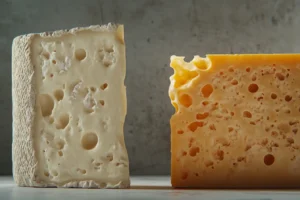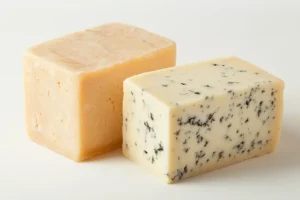This article will explore the main differences between Gruyère and cheddar cheese. It examines their origins, flavors, textures, and uses. This comparison aims to clarify their distinctive characteristics.
Understanding Gruyère and Cheddar: A Detailed Comparison
Many cheeses offer unique flavors and textures. Two popular options are Gruyère and cheddar. Understanding what is the difference between Gruyère and cheddar can improve your culinary experiences. This article will examine their unique qualities. It will also explore their origins and best uses. Furthermore, we will look into specific details related to each cheese. Consequently, this article will offer a complete comparison.
For more insights into specific types of cheese and their uses, explore what is so special about Gruyère cheese.
Origins and History of the Two Cheeses
Firstly, let’s examine the origins of these two cheeses. Gruyère comes from Switzerland, specifically the area around the town of Gruyères. This cheese has a rich history going back centuries. It is traditionally made in large wheels in the Swiss Alps. The exact recipes and techniques have been refined over time. This history adds to the cheese’s unique character. Conversely, cheddar cheese originates from the village of Cheddar in England. Its origins can be traced back to at least the 12th century. Its production was also refined over many years. Therefore, each has a distinct geographical and historical background. These different backgrounds contribute to their unique properties. The history also impacts how they are traditionally used.
Production Methods: Shaping the Texture
Production methods have a major impact on the final cheese. Gruyère is made with cow’s milk. The milk is heated and then pressed into molds. After this, the cheese is placed in brine for curing. This curing process creates its characteristic flavor and texture. Additionally, the brine and temperature affect final consistency. On the other hand, cheddar involves a unique process called “cheddaring.” This includes cutting the curd, stacking it, and pressing it. This unique process develops distinct qualities. These production techniques result in diverse cheese characteristics. Consequently, what is the difference between Gruyère and cheddar is also due to these distinct approaches. These processes result in differing textures and tastes.
Flavor Profiles: A Tale of Two Tastes
The flavor profiles are a major difference between cheddar and Gruyère. Gruyère is known for its nutty and earthy flavor. Furthermore, some describe its taste as slightly sweet. This sweetness balances its savory profile. It has a complex flavor that deepens as it ages. The aging process also affects texture. Cheddar, however, is much more varied. It can range from mild to sharp. Young cheddar can be creamy and mild. Aged cheddar develops a much more pungent and sharp flavor. These flavor variations make it versatile in the kitchen. Therefore, flavor is a key factor in understanding what is the difference between Gruyère and cheddar. These flavor variations stem from different production methods.
Texture and Appearance: Key Differences
The texture and appearance of Gruyère and cheddar also differ. Gruyère is typically firm and dense, with a smooth, almost glossy surface. It can have small holes, known as eyes. This adds to its unique appearance. These small holes are a result of gas release during fermentation. Conversely, cheddar can range from firm to crumbly. This depends on its age and type. The aging process changes its texture. Its color is usually pale yellow to orange. This color variation also signifies different types. These differences enhance understanding of what is the difference between Gruyère and cheddar. They demonstrate their individual characters.
Comparing the Feel and Look of the Cheeses
Gruyère’s texture is generally consistent and smooth. This cheese melts very well, making it excellent for cooking. Its consistent texture is a key characteristic. In addition, cheddar has a more variable texture. Mature cheddar can be quite crumbly. Furthermore, younger cheddar tends to be smoother. These differences affect how they perform in cooking. They also influence flavor perception. The texture can also influence which foods it will pair well with. Because of these variations, you can see clearly what is the difference between Gruyère and cheddar. Texture is an important distinction.
Color Variations and What They Mean
Gruyère has a consistent pale-yellow color. This color comes naturally from the milk. Its natural color is consistent across varieties. However, cheddar exhibits a wider range of colors. Its color can vary from pale white to deep orange. The color can indicate differences in flavor and process. The variation in cheddar color usually comes from adding annatto, a natural coloring. Color plays a key role. It visually distinguishes different types of cheddar. As a result, color further defines what is the difference between Gruyère and cheddar. The color helps consumers easily identify specific cheeses.
Culinary Uses: Where Each Cheese Shines
Culinary applications differ widely between Gruyère and cheddar. Gruyère is ideal for dishes like gratins, fondue, and quiches. Its melting properties make it excellent in cooked dishes. It adds a sophisticated flavor. Conversely, cheddar is very versatile. It is good in sandwiches, sauces, and as a topping. Its wide variety of flavors make it suitable for many different uses. This versatility makes it a staple ingredient in many cuisines. Thus, what is the difference between Gruyère and cheddar shows in their cooking applications. These diverse applications make each cheese unique.
The Best Cooking Applications for Gruyère
Gruyère’s nutty and complex taste makes it a favorite in classic recipes. Its ability to melt smoothly also adds to its appeal. It’s a great choice for dishes that require a smooth and rich cheese. It enhances the overall flavor profile of a dish. In addition, the taste and texture enhance dishes requiring a strong flavor. Consequently, Gruyère is often chosen for its superior melting. Its melting texture enhances the overall culinary experience. These applications highlight the unique qualities of the cheese. Gruyère is a great addition to many culinary delights.
The Versatile Nature of Cheddar in the Kitchen
Cheddar’s versatility in the kitchen is another notable difference. You can use it in many forms: shredded, sliced, or melted. Its sharp flavors are great for strong dishes. It can add a powerful kick to any dish. Milder cheddar works well in recipes that need a subtle cheese flavor. This flexibility enhances its utility. Cheddar’s ability to adapt makes it useful in a wide range of recipes. This is another area illustrating what is the difference between Gruyère and cheddar. Its flavor makes it a staple in many dishes.
Nutritional Aspects of Gruyère and Cheddar
The nutritional content of Gruyère and cheddar is similar in many ways. Both are good sources of proteins and calcium. They also contain fats. However, there are some variations to consider. The fat content can differ based on the specific type of each. It is important to consider these factors when making dietary choices. This information helps you make informed decisions. Therefore, nutritional value also helps understand what is the difference between Gruyère and cheddar. Understanding nutritional aspects helps make informed choices.
Protein and Calcium Content
Both cheeses are good sources of protein. This is essential for body repair and growth. They are also rich in calcium, vital for strong bones. Gruyère and cheddar offer similar levels of these vital nutrients. They are both excellent for building and maintaining healthy bodies. However, the exact amounts can vary based on manufacturing. Understanding these nutritional differences is important for balanced diets. This understanding helps make informed decisions. The nutritional content contributes to the differences in what is the difference between Gruyère and cheddar.
Fat Content and Calories: A Brief Look
Fat content and calories are other factors for consideration. Cheddar, especially the more mature varieties, can be higher in fat. It can be dense in calories. Gruyère also has a high fat content. These are both energy-dense foods. It is important to consider the fat and calorie information when making dietary choices. These factors can help guide consumers. Consumers should be mindful of these factors. Consequently, what is the difference between Gruyère and cheddar also includes these nutritional aspects. These aspects are important for conscious consumers.
Storage and Handling: How to Keep Each Cheese Fresh
Proper storage is essential for both Gruyère and cheddar. This keeps them fresh and delicious. Both cheeses should be stored in the refrigerator, wrapped in wax paper. This avoids drying out. This technique extends the shelf life. This also prevents the cheese from absorbing other flavors. Correct storage will ensure cheese quality and flavor lasts longer. Proper storage helps maintain quality. As a result, proper care highlights what is the difference between Gruyère and cheddar in storage needs. Proper storage is key to keeping cheese enjoyable.
Best Practices for Storing Gruyère
Gruyère should be wrapped tightly in wax paper. Then put it in an airtight container. This prevents drying out and maintains flavor. Store it in the refrigerator’s crisper drawer to maintain humidity. This ensures proper moisture levels. Furthermore, ensure you use a separate container. This can help prevent flavor transfer from other foods. This prevents contamination from strong odors. As a result, these are key to maintaining the cheese’s unique taste and texture. These practices ensure freshness for longer.
Optimal Storage for Cheddar: Tips and Tricks
Cheddar can be stored similarly to Gruyère. Keep it wrapped tightly in wax paper or plastic wrap. This prevents moisture loss and flavor changes. Store it in the refrigerator’s crisper drawer for the best results. This will also help maintain moisture content. It is important to check for mold regularly to ensure quality. This vigilance ensures quality control. These practices ensure the cheese maintains its quality and taste. Proper storage helps prevent spoilage. Consequently, what is the difference between Gruyère and cheddar is also seen in these different storage recommendations.
Summary: Key Distinctions Between Gruyère and Cheddar
To summarize, the main differences between Gruyère and cheddar lie in their origins, flavor, texture, and usage. Gruyère is a nutty and smooth cheese from Switzerland. Cheddar, on the other hand, is a very versatile cheese from England. Its taste can vary widely from mild to sharp. They both have their unique place in culinary applications. These differences make each cheese unique. Understanding these differences is essential for cheese lovers and chefs. This understanding enhances the culinary experience. In conclusion, what is the difference between Gruyère and cheddar is a combination of these factors.
Choosing Between Gruyère and Cheddar: A Matter of Taste
The choice between Gruyère and cheddar ultimately depends on personal preference. Consider your culinary needs and flavor desires. Gruyère is perfect when you want a smooth, nutty cheese for cooking. It is great for adding a sophisticated note. Cheddar is very flexible and is ideal for many applications. Its versatility makes it suitable for many dishes. Therefore, each has its merits, making cheese selection a matter of personal choice. Choosing the right cheese enhances your cooking. This decision highlights what is the difference between Gruyère and cheddar. The right choice improves the culinary outcome.
Considering Recipes and Preferred Flavors
When choosing, consider the specific recipe. Gruyère enhances dishes where a nutty flavor and smooth melt are needed. It enhances the overall taste. Conversely, cheddar’s many flavor variations allow it to be flexible in cooking. Its versatility makes it great for many dishes. Consider if you prefer mild or sharp flavors. These preferences will guide your choice. Flavor preferences are key to making the correct decision. Therefore, aligning taste with cheese properties enhances culinary success. This alignment is key to a successful meal.
How to Pair Gruyère and Cheddar With Other Foods
Both Gruyère and cheddar pair well with many foods. Gruyère goes well with white wine, fruits, and nuts. Its nutty notes compliment these flavors well. Cheddar is good with beers, apples, and charcuterie. *These strong flavors match perfectly. These pairings enhance the flavor experience of each cheese. Flavor pairings are great to explore different culinary delights. By understanding flavor profiles, you can make delightful combinations. These pairings demonstrate what is the difference between Gruyère and cheddar in a culinary context. Pairing opens up different culinary possibilities.
Frequently Asked Questions (FAQs)
What is the main difference between Gruyère and Cheddar?
The main difference between Gruyère and cheddar lies in their origin, flavor, and texture. Gruyère is a Swiss cheese with a nutty, earthy flavor and smooth texture. Cheddar, on the other hand, is an English cheese with a wide range of flavors from mild to sharp and a varied texture from smooth to crumbly. They also have different uses in cooking. Their origins and production methods also vary.
Can you substitute Gruyère for Cheddar, and vice versa?
You can substitute Gruyère for cheddar, but they will give a different result. Gruyère melts smoothly, making it great for sauces and gratins. Cheddar is more versatile for sandwiches, toppings, and cooked dishes. Their flavors are also distinct. Therefore, the swap should be based on the desired outcome. The outcome will depend on the specific characteristics. You should consider how flavor and texture impact your dish when substituting. These aspects are important to consider when substituting.
Is Gruyère a hard or soft cheese compared to Cheddar?
Gruyère is generally a semi-hard cheese, while cheddar can range from semi-hard to hard based on age. They have different textures. Gruyère has a firm and smooth texture. Cheddar can be firm or crumbly. Therefore, they have different textures. These differences are mainly a result of different production techniques. Gruyère is consistent in texture, whereas cheddar has variations.
Which cheese is better for melting: Gruyère or Cheddar?
Gruyère is generally better for melting than cheddar. It melts very smoothly. This makes it ideal for dishes like fondue, gratins, and quiches. Its melting texture is very smooth. Cheddar melts well, too. However, its texture can become stringy, particularly with certain older types. Because of this, Gruyère is often preferred when a smooth melt is key. The final texture is different from Gruyere.
Conclusion
In conclusion, the world of cheese offers diverse options. Gruyère and cheddar, while both beloved, have distinct characteristics. They both add unique qualities to many dishes. Understanding what is the difference between Gruyère and cheddar enhances your culinary skills. This understanding enables you to choose the best cheese for your needs. Whether you prefer the nutty smoothness of Gruyère or the versatile flavors of cheddar, there is a cheese that matches every need. They both are important in the culinary world. Appreciating the differences is key for any cheese enthusiast. This exploration improves culinary creativity.
If you’re looking for comparisons between similar cheeses, you might find our guide on is Gruyère cheese the same as Gouda particularly helpful.




